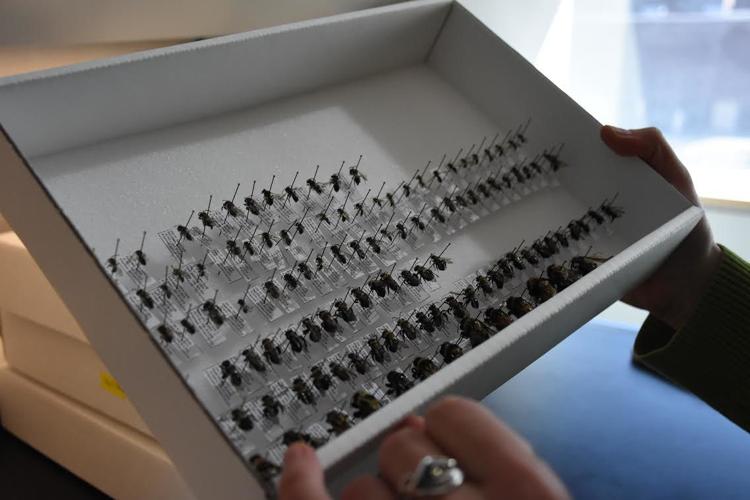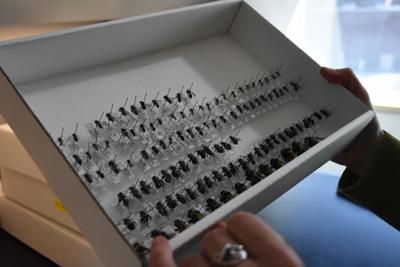Researchers at Penn State and around the country have come together to create a website that will offer an inside look into the lives of nature’s pollinators.
Beescape is a website that allows beekeepers or casual gardeners alike to provide data about the regions they live in and how the region affects the bee population. It was recently released online as a beta site following years of evaluation and research.
Christina Grozinger, distinguished professor of entomology and director of the Center for Pollinator Research, has been one of the staff members at the forefront of the project. Grozinger said that discussion on “stressors that determine bee health” has been brewing for years.
Recently, researchers discovered that some of the biggest impacts on a bee can be the area it’s exposed to.
“Bees forage over very large distances, and so an individual person cannot really control what the bees experience, and often they do not really know what their bees experience,” Grozinger said via email.
Harland Patch, research associate of entomology at Penn State, said the inspiration for Beescape partially derived from a partnership with researchers in Kenya. Patch said the researchers have studied how landscapes affect honey bees, which aren’t kept in hives as many honey bees are in the United States.
The website is designed to allow anyone to input their location and examine data collected on the nesting quality, insecticide quality and floral quality of every season but winter within a certain range. With the mobility of the site, people will be able to better understand where bees may be traveling to and why they are being affected by the different locations.
The focus on landscape stemmed from the different things that affect both honey bees and wild bees. Patch said bee health is influenced by pesticides, parasites, poor nutrition and pathogens. He explained that each of these factors work together, and one way to understand these interactions is through examining the landscape.
Through the data collected, Patch believes that Beescape can offer advice to beekeepers and gardeners about the resources needed in different habitats. Data from the website can help determine an overabundance or lack of a specific resource in a location, so beekeepers in that location know what to supplement.
Currently, the site only has maps available for Pennsylvania, Indiana and Illinois. These maps show estimated models of the different factors affecting bees in the region. Grozinger said this makes it difficult for local sites to have entirely accurate information. However, Grozinger hopes to expand the data in the future to different states with more accurate estimates.
Melanie Kammerer believes that the challenge of expanding the data to different regions has been a “motivation” to create Beescape.

Beescape translates satellite imagery into the quality of floral resources throughout spring, summer and fall in State College, Pennsylvania.
Kammerer (graduate-entomology) has helped research wild bees and create the calculations necessary in designing the maps. She said there must be a vast amount of information in order to create correlations between bee health and environmental factors. Through Beescape, Kammerer believes they will be able to overcome this challenge.
“The scale of the data is somewhat difficult to accomplish, but that’s part of the reason why we’re trying to get more [data] with Beescape,” Kammerer said.
The goal of Beescape is to retrieve data from beekeepers across the country in order to improve the current models that are available. The website is able to be accessed by anyone, even if there aren’t current models in their area. Patch said people can sign up to participate in a study on the website to provide more data which can improve the current information available.
However, Grozinger has said that this has posed a challenge in developing Beescape. She said the site includes surveys for participants to update and monitor the health of their bees, though it was difficult to ensure these surveys would provide enough information without being too “complicated” or “confusing.”
Yet, the models created so far have allowed researchers to understand different patterns that affect bee health.
Kammerer said it has shown that bees during different times of the years have different vulnerabilities to the landscape. She explained spring bees live very short lives, focusing their time on gathering pollen and nectar, storing nests and laying eggs. These bees live through April until the middle of May when a “new species” of summer bees emerge.
Due to their limited life span, spring bees are particularly sensitive to the landscape they interact with. Kammerer said they “respond more strongly to how much available nesting there is and how much floral resources [there are].”
Additionally, Patch said floral life has proven to be a large impact on bee health. He explained that areas with more flowers often contain bees in better health. However, the quality of the flowers is also a factor that affects a bee’s quality of life.
The ultimate goal of Beescape is to allow individuals to interact with the data for themselves in order to benefit the greater good of the research. Kammerer said that the website is meant to provide a “more meaningful” experience than a scientific paper.
There have been several beekeepers the team has been working with who are able to get these hands-on experiences with the website. Charlie Vorisek is a full time beekeeper in Crawford County, Pennsylvania and has been able to benefit from Beescape through his work with the research.

The first step to getting started in Beescape is to type in a location before being shown the different qualities of nesting, insecticides and floral life throughout the different seasons in a specific range.
Vorisek said that Beescape has allowed him to become more aware of the area his bees are being kept in. Specifically, he explained that he has begun monitoring varroa mites, which he described as the “number one problem” for bee health. Varroa mites are parasites that feed on the bees, weaken their larvae and shorten their lifespans.
Without partnerships with beekeepers like Vorisek, Beescape would have been difficult to launch. Additionally, the project was made possible through collaborations with the University of Illinois, University of Wisconsin, University of Minnesota, University of California and Dickinson College. The full list of collaborators can be found on the Beescape website.
Patch said Beescape was “only doable through a collaboration of people with many different skill sets.” These partnerships will consequently allow the project to spread further throughout the United States.
While the website may have some limitations, Patch describes the current state of Beescape as “just the beginning.” He hopes that the future will allow the project to improve data for beekeepers and scientists alike to foster a more in-depth look into factors affecting bee health.
“We hope that the site will help bring together individuals from a larger community to have discussions about how they can improve bee health in these broader landscapes,” Grozinger said.
RELATED
For university scientists and student volunteers, the reality of bee deaths during winter is harsh.
The Class Gift of 2019 ignored two meaningful gift options in favor of an entrance gate









